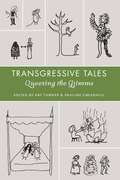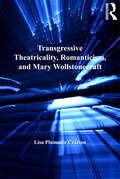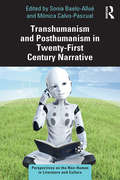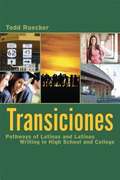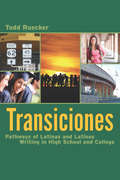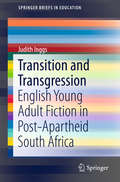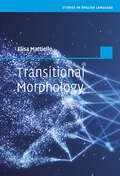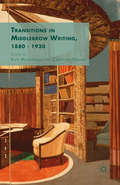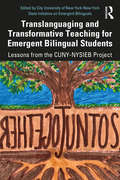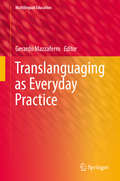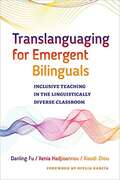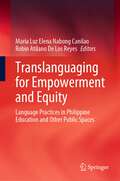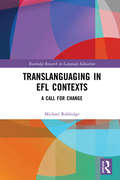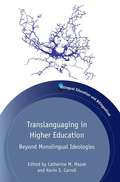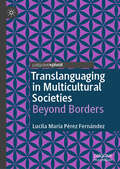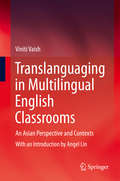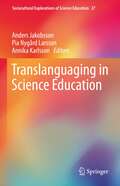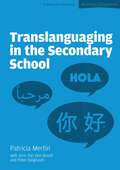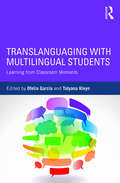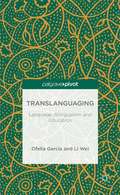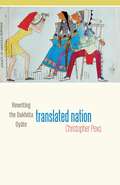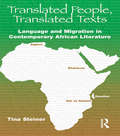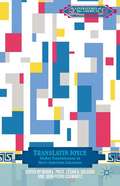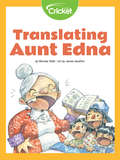- Table View
- List View
Transgressive Tales: Queering the Grimms
by Pauline Greenhill Kay TurnerThe stories in the Grimm brothers' Kinder- und Hausmärchen (Children's and Household Tales), first published in 1812 and 1815, have come to define academic and popular understandings of the fairy tale genre. Yet over a period of forty years, the brothers, especially Wilhelm, revised, edited, sanitized, and bowdlerized the tales, publishing the seventh and final edition in 1857 with many of the sexual implications removed. However, the contributors in Transgressive Tales: Queering the Grimms demonstrate that the Grimms and other collectors paid less attention to ridding the tales of non-heterosexual implications and that, in fact, the Grimms' tales are rich with queer possibilities. Editors Kay Turner and Pauline Greenhill introduce the volume with an overview of the tales' literary and interpretive history, surveying their queerness in terms of not just sex, gender and sexuality, but also issues of marginalization, oddity, and not fitting into society. In three thematic sections, contributors then consider a range of tales and their queer themes. In Faux Femininities, essays explore female characters, and their relationships and feminine representation in the tales. Contributors to Revising Rewritings consider queer elements in rewritings of the Grimms' tales, including Angela Carter's The Bloody Chamber, Jeanette Winterson's Twelve Dancing Princesses, and contemporary reinterpretations of both "Snow White" and "Snow White and Rose Red." Contributors in the final section, Queering the Tales, consider queer elements in some of the Grimms' original tales and explore intriguing issues of gender, biology, patriarchy, and transgression. With the variety of unique perspectives in Transgressive Tales, readers will find new appreciation for the lasting power of the fairy-tale genre. Scholars of fairy-tale studies and gender and sexuality studies will enjoy this thought-provoking volume.
Transgressive Theatricality, Romanticism, and Mary Wollstonecraft
by Lisa Plummer CraftonThroughout her works, Mary Wollstonecraft interrogates and represents the connected network of theater, culture, and self-representation, in what Lisa Plummer Crafton argues is a conscious appropriation of theater in its literal, cultural, and figurative dimensions. Situating Wollstonecraft within early Romantic debates about theatricality, she explores Wollstonecraft's appropriation of, immersion in, and contributions to these debates within the contexts of philosophical arguments about the utility of theater and spectacle; the political discourse of the French Revolution; juridical transcripts of treason and civil divorce trials; and the spectacle of the female actress in performance, as typified by Sarah Siddons and her compelling connections to Wollstonecraft on and off stage. As she considers Wollstonecraft's contributions to competing notions of the theatrical, from the writer's earliest literary reviews and translations through her histories, correspondence, nonfiction, and novels, Crafton traces the trajectory of Wollstonecraft's conscious appropriation of the trope and her emphasis on theatricality's transgressive potential for self-invention. Crafton's book, the first wide-ranging study of theatricality in the works of Wollstonecraft, is an important contribution to current reconsiderations of the earlier received wisdom about Romantic anti-theatricality, to historicist revisions of the performance and theory of Sarah Siddons, and to theories of spectacle and gender.
Transhumanism and Posthumanism in Twenty-First Century Narrative (Perspectives on the Non-Human in Literature and Culture)
by Sonia Baelo-AlluéTranshumanism and Posthumanism in Twenty-First Century Narrative brings together fifteen scholars from five different countries to explore the different ways in which the posthuman has been addressed in contemporary culture and more specifically in key narratives, written in the second decade of the 21st century, by Dave Eggers, William Gibson, John Shirley, Tom McCarthy, Jeff Vandermeer, Don DeLillo, Margaret Atwood, Cixin Liu and Helen Marshall. Some of these works engage in the premises and perils of transhumanism, while others explore the qualities of the (post)human in a variety of dystopian futures marked by the planetary influence of human action. From a critical posthumanist perspective that questions anthropocentrism, human exceptionalism and the centrality of the ‘human’ subject in the era of the Anthropocene, the scholars in this collection analyse the aesthetic choices these authors make to depict the posthuman and its aftereffects.
Transiciones
by Todd RueckerTransiciones is a thorough ethnography of seven Latino students in transition between high school and community college or university. Data gathered over two years of interviews with the students, their high school English teachers, and their writing teachers and administrators at postsecondary institutions reveal a rich picture of the conflicted experience of these students as they attempted to balance the demands of schooling with a variety of personal responsibilities.Todd Ruecker explores the disconnect between students' writing experiences in high school and higher education and examines the integral role that writing plays in college. Considering the almost universal requirement that students take a writing class in their critical first year of college, he contends that it is essential for composition researchers and teachers to gain a fuller understanding of the role they play in supporting and hindering Latina and Latino students' transition to college.Arguing for situating writing programs in larger discussions of high school / college alignment, student engagement, and retention, Transiciones raises the profile of what writing programs can do, while calling composition teachers, administrators, and scholars to engage in more collaboration across the institution, across institutions, and across disciplines to make the transition from high school to college writing more successful for this important group of students.
Transiciones: Pathways of Latinas and Latinos Writing in High School and College
by Todd RueckerTransiciones is a thorough ethnography of seven Latino students in transition between high school and community college or university. Data gathered over two years of interviews with the students, their high school English teachers, and their writing teachers and administrators at postsecondary institutions reveal a rich picture of the conflicted experience of these students as they attempted to balance the demands of schooling with a variety of personal responsibilities. Todd Ruecker explores the disconnect between students’ writing experiences in high school and higher education and examines the integral role that writing plays in college. Considering the almost universal requirement that students take a writing class in their critical first year of college, he contends that it is essential for composition researchers and teachers to gain a fuller understanding of the role they play in supporting and hindering Latina and Latino students’ transition to college. Arguing for situating writing programs in larger discussions of high school/college alignment, student engagement, and retention, Transiciones raises the profile of what writing programs can do while calling composition teachers, administrators, and scholars to engage in more collaboration across the institution, across institutions, and across disciplines to make the transition from high school to college writing more successful for this important group of students.
Transition and Transgression
by Judith InggsThis book conveys the story of a society in the throes of restructuring itself and struggling to find a new identity. A particularly attractive aspect of this study is the focus on young adult literature and its place in post-apartheid South Africa, as well as its potential use in the classroom and lecture hall. Intersecting these two topics provides a compelling lens for refocusing debate on young adult fiction while offering a new and novel angle on debates in South Africa after the end of apartheid. The multilingual and multicultural South African society has resulted in fiction that differs from other parts of the English-speaking world. This work presents a holistic critique of South African young adult fiction and addresses issues such as change and transformation, identity politics, sexuality, and the issue of the right of white writers to represent and "write" characters of different races.
Transitional Morphology: Combining Forms in Modern English (Studies in English Language)
by Elisa MattielloCombining Forms (CFs) are a major morphological phenomenon in Modern English, yet while they have been discussed in some morphological literature, no full-length study has been devoted to this topic so far. This pioneering book addresses that gap by providing a framework in which CFs are marked as distinct from their neighbouring categories such as abbreviations and blending. It splits CFs into four distinct categories – neoclassical (e.g. bio-therapy, zoo-logy), abbreviated (e.g. e-reader, econo-politics), secreted (e.g. oil-gate, computer-holic) and splinters (e.g. docu- from documentary in docudrama). It shows that the notion of CF spans a wide spectrum of processes, from regular composition to abbreviation, from blending to analogy, and schema. Modern and emerging English CFs are analysed by adopting a corpus-based approach, and measuring their realised, expanding, and potential productivity. Comprehensive yet accessible, it is essential reading for researchers and advanced students of morphology, English historical linguistics, corpus linguistics, and lexicography.
Transitions in Middlebrow Writing, 1880–1930
by Kate Macdonald Christoph SingerThis book examines the connections evident between the simultaneous emergence of British modernism and middlebrow literary culture from 1880 to the 1930s. The essays illustrate the mutual influences of modernist and middlebrow authors, critics, publishers and magazines.
Translanguaging and Transformative Teaching for Emergent Bilingual Students: Lessons from the CUNY-NYSIEB Project
by Ofelia GarcíaA critical and accessible text, this book provides a foundation for translanguaging theory and practice with educating emergent bilingual students. The product of the internationally renowned and trailblazing City University of New York-New York State Initiative on Emergent Bilinguals (CUNY-NYSIEB), this book draws on a common vision of translanguaging to present different perspectives of its practice and outcomes in real schools. It tells the story of the collaborative project’s positive impact on instruction and assessment in different contexts, and explores the potential for transformation in teacher education. Acknowledging oppressive traditions and obstacles facing language minoritized students, this book provides a pathway for combatting racism, monolingualism, classism and colonialism in the classroom and offers narratives, strategies and pedagogical practices to liberate and engage emergent bilingual students. This book is an essential text for all teacher educators, researchers, scholars, and students in TESOL and bilingual education, as well as educators working with language minoritized students.
Translanguaging as Everyday Practice (Multilingual Education #28)
by Gerardo MazzaferroThis volume offers empirically grounded perspectives on translanguaging as a locally situated, interactional accomplishment of practical action, and its significance within different domains of social life-school, education, diasporic families and communities, workplaces, urban linguistic landscapes, advertising practices and mental health centres – focusing on case studies from different countries and continents. The 14 chapters contribute to the understanding of translanguaging as a communicative and discursive practice, which is relationally constructed and strategically deployed by individuals during everyday encounters with language and cultural diversity. The contributions testify to translanguaging as an interdisciplinary and critical research paradigm by assembling scholars working on translanguaging from different perspectives, and a wide range of social, cultural, and geographical contexts. This volume contributes to the further development of new theoretical and analytical tools for the investigation of translanguaging as everyday practice, and how and why language practices are constructed, negotiated, opposed or subverted by social actors.
Translanguaging for Emergent Bilinguals: Inclusive Teaching in the Linguistically Diverse Classroom
by Donna E. Alvermann Ofelia García Celia Genishi Danling Fu Xenia Hadjioannou Xiaodi ZhouTranslanguaging for Emergent Bilinguals is a thorough examination of the development, evolution, and current realities of educating emergent bilinguals in U.S. classrooms. <p><p> Through engaging vignettes, readers follow the experiences of emergent bilinguals in a variety of monolingual settings, tracing the challenges encountered by both the students and the schools that serve them. The authors argue that the future of emergent bilingual education lies in an inclusive translanguaging pedagogy. By embracing home languages and cultures, this approach nurtures the development of multiple literacies, enabling individuals to thrive academically, socially, linguistically, and intellectually. <p><p> The text begins by showing how the authors evolved from monolingual language educators to translanguaging educators and ends with concrete takeaways for successfully using this approach in different education settings.
Translanguaging for Empowerment and Equity: Language Practices in Philippine Education and Other Public Spaces
by Maria Luz Elena Nabong Canilao Robin Atilano De Los ReyesThis book investigates how translanguaging is employed for pedagogical purposes and describes how speakers use translanguaging in specific multilingual contexts. It examines the beliefs and perceptions that shape translanguaging in different public spaces and interrogates the notion of translanguaging through the lens of various Philippine public spaces. This book also focuses on the breakthroughs that may be achieved through translanguaging in the academic field and other domains. It presents studies conducted in the Philippines, a multilingual and post-colonial setting where many multilingual speakers engage in translanguaging practices while recognizing the significance of each language in their communication repertoire in expressing their ideas and identities. It provides insights and knowledge on the current language practices in basic and tertiary education and offers more information about the crucial role of translanguaging in the government, media, and church domains in the Philippines. While this book mainly covers the use of translanguaging in various domains in the Philippines, it remains relevant to other multilingual societies around the world. Being a highly multilingual society, the Philippines serves as a global case study for understanding multilingualism. This book demonstrates how blocks to translanguaging may be overcome and explores possibilities that may be considered in introducing it as an effective pedagogical and communication tool. It emphasizes the importance of recognizing the translingual paradigm as a strong force that has been adopted by multilingual language users to promote empowerment and equity.
Translanguaging in EFL Contexts: A Call for Change (Routledge Research in Language Education)
by Michael RabbidgeThe purpose of this book is to promote the value of translanguaging in EFL teaching contexts. To date, translanguaging has been discussed mostly in regards to US and European contexts. This book will examine the teaching beliefs and practices of teachers within a South Korean elementary school context to evaluate the practices of current teachers who use translanguaging strategies when teaching. This examination utilizes sociological theories of pedagogic discourse to discuss the consequences of language exclusion policies on the peninsula. Using these theories, it presents an argument for why EFL contexts like South Korea need to reevaluate their current policies and understandings of language learning and teaching. By embracing translanguaging as an approach, the author argues, they will transform their traditional notions of language learning and teaching in order to view teachers as bilinguals, and learners as emerging bilinguals, rather than use terms of deficiency that have traditionally been in place for such contexts. This book's unique use of sociological theories of pedagogic discourse supports a need to promote the translanguaging ideology of language teaching and learning.
Translanguaging in Higher Education: Beyond Monolingual Ideologies
by Catherine M. Mazak Kevin S. CarrollThis book examines translanguaging in higher education and provides clear examples of what translanguaging looks like in practice in particular contexts around the world. While higher education has historically been seen as a monolingual space, the case studies from the international contexts included in this collection show us that institutions of higher education are often translingual spaces that reflect the multilingual environments in which they exist. Chapters demonstrate how the use of translanguaging practices within the context of global higher education, where English plays an increasingly important role, allows students and professors to build on their linguistic repertoires to more efficiently and effectively learn content. The documentation of such practices within the context of higher education will further legitimatize translanguaging practices and may lead to their increased use not only in higher education but also in both primary and secondary schools.
Translanguaging in Multicultural Societies: Beyond Borders
by Lucila María Pérez FernándezThis book delves into the multifaceted concept of translanguaging, offering a comprehensive examination from its foundational theories to its practical applications. The author provides a nuanced understanding of translanguaging, differentiating it from code-switching and elucidating its core premises, then explores translanguaging practices in early multilingual societies, colonial contexts, and postcolonial and globalized settings. Theoretical foundations are thoroughly explored in the second part of the book, covering sociolinguistic theories and their application to translanguaging, cognitive approaches emphasizing metacognition and cognitive flexibility, psycholinguistic perspectives, and sociocultural theories aligning with translanguaging. Part III examines practical aspects of translanguaging, focusing on its implementation in multilingual classrooms, multicultural communities, and professional settings. The book demonstrates translanguaging's role in community development, cultural heritage preservation, and fostering social cohesion through case studies in diverse contexts, including business, healthcare, and legal settings. Strategies and best practices for integrating translanguaging into language teaching are discussed, along with its benefits and challenges in education. The final section, Part IV, anticipates future directions for translanguaging, exploring emerging technologies such as virtual reality, augmented reality, artificial intelligence, and machine learning. The book also examines translanguaging's potential in linguistic preservation, particularly in the context of indigenous languages, as well as its role in achieving Sustainable Development Goals, including multilingual education and reducing linguistic inequalities. This book will be of interest to researchers, scholars, and educators interested in language studies, sociolinguistics, education, and interdisciplinary fields.
Translanguaging in Multilingual English Classrooms: An Asian Perspective and Contexts
by Viniti VaishThis book is the first to apply the theory of translanguaging to multilingual classrooms in an Asian context, offering strategies for teaching specific grammatical and comprehension skills to students struggling to read in English. It also enriches the methodology of coding bilingual transcripts with ideas resulting from a detailed analysis of a large and rich data set. Lastly, the author discusses growth areas in the emerging field of translanguaging and challenges for teachers implementing a translanguaging approach in a superdiverse classroom.
Translanguaging in Science Education (Sociocultural Explorations of Science Education #27)
by Anders Jakobsson Pia Nygård Larsson Annika KarlssonThis edited volume explores diverse translanguaging practices in multilingual science classrooms in Hong Kong, Lebanon, Luxembourg, South Africa, Sweden and the United States. It presents novel opportunities for using students’ home, first or minority languages as meaning-making tools in science education. It also invites to explore the use of language resources and other multimodal resources, such as gestures and body language. In addition, it discusses and problematizes contingent hindrances and obstacles that may arise from these practices within various contexts around the world. This includes reviewing different theoretical starting points that may be challenged by such an approach. These issues are explored from different perspectives and methodological focus, as well as in several educational contexts, including primary, middle, secondary levels, higher education, as well as in after-school programs for refugee teenagers. Within these contexts, the book highlights and shares a range of educational tools and activities in science education, such as teacher-led classroom-talk, language-focused teaching, teachers’ use of meta-language, teachers’ scaffolding strategies, small-group interactions, and computer-supported collaborative learning.
Translanguaging in the Secondary School
by Patricia MertinIn schools across the world, there are large numbers of students who are not native speakers of the language of instruction in their classroom. This leads to challenges for the teachers, students and parents. Translanguaging enables students who are second language leaners to build on previous learning, access the curriculum more effectively, learn with greater depth of understanding, improve their ability to speak and write the academic language of instruction and continue to develop their mother tongue. This book describes the origin and development of translanguaging. It explains the present situation in many secondary schools and the challenges which are faced by teachers, students and their parents. It aligns the power of translanguaging with cognitive psychologists' theories of effective learning. Concrete suggestions are offered to support teaching and learning with real examples from practice given by classroom teachers.
Translanguaging in the Secondary School
by Patricia MertinIn schools across the world, there are large numbers of students who are not native speakers of the language of instruction in their classroom. This leads to challenges for the teachers, students and parents. Translanguaging enables students who are second language leaners to build on previous learning, access the curriculum more effectively, learn with greater depth of understanding, improve their ability to speak and write the academic language of instruction and continue to develop their mother tongue. This book describes the origin and development of translanguaging. It explains the present situation in many secondary schools and the challenges which are faced by teachers, students and their parents. It aligns the power of translanguaging with cognitive psychologists' theories of effective learning. Concrete suggestions are offered to support teaching and learning with real examples from practice given by classroom teachers.
Translanguaging with Multilingual Students: Learning from Classroom Moments
by Ofelia García Tatyana KleynLooking closely at what happens when translanguaging is actively taken up to teach emergent bilingual students across different contexts, this book focuses on how it is already happening in classrooms as well as how it can be implemented as a pedagogical orientation. It extends theoretical understandings of the concept and highlights its promises and challenges. Using a Transformative Action Research design, six empirically grounded ethnographic case studies describe how translanguaging is used in lesson designs and in the spontaneous moves made by teachers and students during specific teaching moments. The cases shed light on two questions: How, when, and why is translanguaging taken up or resisted by students and teachers? What does its use mean for them? Although grounded in a U.S. context, and specifically in classrooms in New York State, Translanguaging with Multilingual Students links findings and theories to different global contexts to offer important lessons for educators worldwide.
Translanguaging: Language, Bilingualism and Education
by Li Wei Ofelia GarcíaThis book addresses how the new linguistic concept of 'Translanguaging' has contributed to our understandings of language, bilingualism and education, with potential to transform not only semiotic systems and speaker subjectivities, but also social structures.
Translated Nation: Rewriting the Dakhóta Oyáte
by Christopher J. PexaHow authors rendered Dakhóta philosophy by literary means to encode ethical and political connectedness and sovereign life within a settler surveillance stateTranslated Nation examines literary works and oral histories by Dakhóta intellectuals from the aftermath of the 1862 U.S.–Dakota War to the present day, highlighting creative Dakhóta responses to violences of the settler colonial state. Christopher Pexa argues that the assimilation era of federal U.S. law and policy was far from an idle one for the Dakhóta people, but rather involved remaking the Oyáte (the Očéti Šakówiŋ Oyáte or People of the Seven Council Fires) through the encrypting of Dakhóta political and relational norms in plain view of settler audiences.From Nicholas Black Elk to Charles Alexander Eastman to Ella Cara Deloria, Pexa analyzes well-known writers from a tribally centered perspective that highlights their contributions to Dakhóta/Lakhóta philosophy and politics. He explores how these authors, as well as oral histories from the Spirit Lake Dakhóta Nation, invoke thióšpaye (extended family or kinship) ethics to critique U.S. legal translations of Dakhóta relations and politics into liberal molds of heteronormativity, individualism, property, and citizenship. He examines how Dakhóta intellectuals remained part of their social frameworks even while negotiating the possibilities and violence of settler colonial framings, ideologies, and social forms. Bringing together oral and written as well as past and present literatures, Translated Nation expands our sense of literary archives and political agency and demonstrates how Dakhóta peoplehood not only emerges over time but in everyday places, activities, and stories. It provides a distinctive view of the hidden vibrancy of a historical period that is often tied only to Indigenous survival.
Translated People,Translated Texts
by Tina SteinerTranslated People, Translated Texts examines contemporary migration narratives by four African writers who live in the diaspora and write in English: Leila Aboulela and Jamal Mahjoub from the Sudan, now living in Scotland and Spain respectively, and Abdulrazak Gurnah and Moyez G. Vassanji from Tanzania, now residing in the UK and Canada. Focusing on how language operates in relation to both culture and identity, Steiner foregrounds the complexities of migration as cultural translation. Cultural translation is a concept which locates itself in postcolonial literary theory as well as translation studies. The manipulation of English in such a way as to signify translated experience is crucial in this regard. The study focuses on a particular angle on cultural translation for each writer under discussion: translation of Islam and the strategic use of nostalgia in Leila Aboulela's texts; translation and the production of scholarly knowledge in Jamal Mahjoub's novels; translation and storytelling in Abdulrazak Gurnah's fiction; and translation between the individual and old and new communities in Vassanji's work. Translated People, Translated Texts makes a significant contribution to our understanding of migration as a common condition of the postcolonial world and offers a welcome insight into particular travellers and their unique translations.
Translatin Joyce
by Brian L. Price César A. Salgado John Pedro SchwartzTransLatin Joyce explores the circulation of James Joyce's work in the Ibero-American literary system. The essays address Joycean literary engagements in Spain, Portugal, Argentina, Mexico, and Cuba, using concepts from postcolonial translation studies, antimodernism, game theory, sound studies, deconstruction, and post-Euclidean physics.
Translating Aunt Edna
by Rhonda TelferThree boys decide to play a trick on their aunt, who insists on teaching them new vocabulary words. The English language can be complicated. There are so many words that describe the same thing! You can learn about many of those words in this silly story about a group of siblings who decide they are sick of learning new words!
